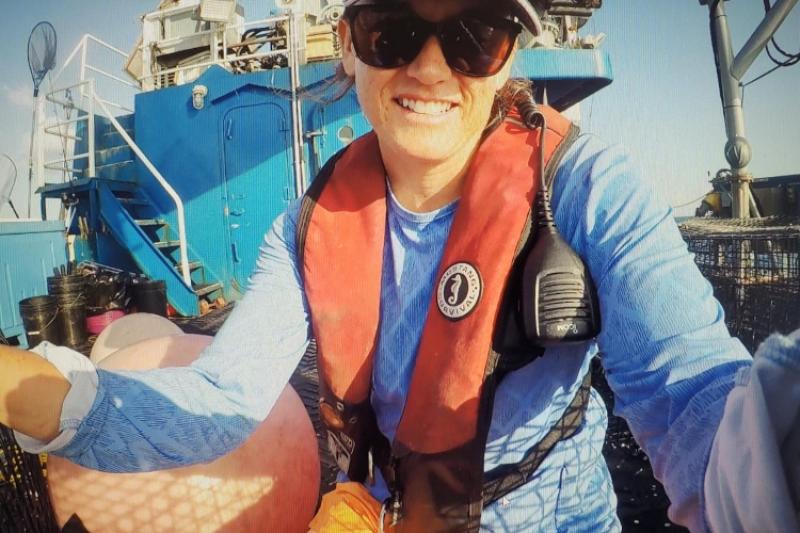Where did you grow up?
I grew up in Hawaii on the island of Kauaʻi. I spent most of my childhood in and on the water. My dad was a free diver and a big spearfisher when I was a kid, so we spent a lot of time snorkeling. When we were little, my sister and I would watch in mock horror as he cleaned fish, but we were always entranced when he would open the stomach of an ulua (giant trevally) and we'd get to dissect what was inside (nearly whole lobsters!). In high school, I didn't know exactly what a career in marine biology entailed but I knew I wanted to spend as much time as possible in the water.
Where did you go to school and in what subject did you get your degree(s)?
I left Hawaii for college at the University of California Santa Cruz, where I majored in Marine Biology. A few years later I attended graduate school at Oregon State University and obtained a master’s degree in wildlife science. My graduate work was part of a National Science Foundation Long-Term Ecological Research project based at Palmer Station on the Western Antarctic Peninsula. There, I studied the effects of climate-induced range shifts on the foraging ecology of Adélie and Gentoo penguins.
How did you come to work at the Southeast Fisheries Science Center?
My career path zigzagged a few oceans and spanned a multitude of marine species leading up to working at the Southeast Fisheries Science Center. My first job out of college was as a NOAA affiliate at the Pacific Islands Fisheries Science Center working as a field technician for the Hawaiian Monk Seal Research Program on Laysan Island in Papahānaumokuākea. After that first dream job, I continued working on pinniped, seabird, and cetacean population monitoring and recovery projects on other Hawaiian Islands, off the coast of California, and in the Antarctic. Somewhere in that time I fell in love with another field biologist who lived in North Carolina and I moved from Hawaii to the East Coast. I was very fortunate to find a position open within the Southeast Fishery Independent Survey group. I convinced them that censusing a large penguin colony is a lot like trying to count a school of 200 vermilion snapper in a single video frame. I didn’t actually say that, but had I known what vermilion snapper were and how challenging it is to count them on a video, I might have.
What do you do at the science center?
I work with the Southeast Fisheries-Independent Survey group, based in Beaufort, North Carolina, in the Population and Ecosystems Monitoring Division. We support stock assessments of reef fish in the U.S. South Atlantic by conducting annual trap video surveys and processing underwater video footage. We spend a good part of May through September working on the R/V Savannah and NOAA ship Pisces, setting chevron fish traps, collecting video data, and processing thousands of fish to collect otoliths and other biological samples. It’s a great time of year, where I spend a lot of time in the sun smelling like decomposing menhaden and covered in red snapper slime. Throughout the rest of the year, I work with others to read the videos collected over the course of the cruise season to provide up-to-date data and indices of abundance for priority species like red snapper and gray triggerfish. The next year, we do it all over again!
What do you like most about your position?
I have always enjoyed the field work aspect of research, and I appreciate that I get to spend a good amount of time outside working on the ocean. Though fisheries science was not an area I pursued early in my career, I’ve always aimed to work on projects who prioritized direct conservation or management outcomes. I like that the data we collect is consequential to fisheries management and the health of our marine ecosystems.
What advice would you have for someone interested in a career at NOAA Fisheries?
I would advise someone interested in a career at NOAA Fisheries to try and collaborate with a NOAA scientist or lab early on. Volunteer, or try to create an undergraduate or graduate project that has ties to a current NOAA project. That way when you are finished with school you might have an option to keep working on that project. Along the way, ask a lot of questions (e.g. what skills and abilities should you obtain to move away from a volunteer position? What is the difference between a contractor and a federal position at NOAA?).
Is there a book, quote, or person that influenced you to be the person that you are today? Tell us why.
“Mālama ʻāina” is a Hawaiian phrase that means caring for and honoring the land. Growing up on an island surrounded by ocean, you realize the importance of taking care of the land and sea and preserving the resources it provides.
What do you like to do outside of work?
Surfing makes me extremely happy but it’s a somewhat rare occurrence so I find joy in other activities like thrifting, yardwork, Crossfit, and live music (I love the band My Morning Jacket!). The more of my family and friends I have alongside me for all that, the better.






